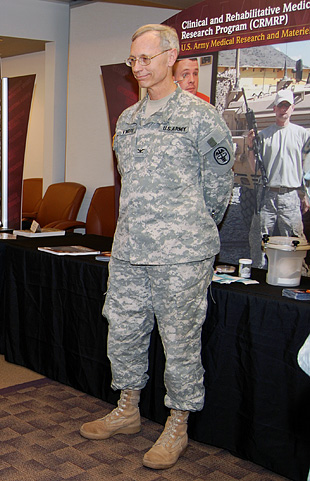"MRMC booth babe retires"

Col. Bob Vandre briefing VIPs at headquarters.
Fast facts about Vandre:
- His five sons are all Eagle Scouts and he served seven years as a scout master.
- He sang in a barbershop quartet for a few years until the other members moved away.
- He served two times as a bishop in the Church of Jesus Christ of Latter-Day Saints (the Mormon church).
- In college, he played in the UCLA marching band and worked part-time for the Aerospace Corporation doing research on nuclear weapons effects on semiconductors and spacecraft charging.
Col. Bob Vandre briefing VIPs at headquarters.
Fast facts about Vandre:
- His five sons are all Eagle Scouts and he served seven years as a scout master.
- He sang in a barbershop quartet for a few years until the other members moved away.
- He served two times as a bishop in the Church of Jesus Christ of Latter-Day Saints (the Mormon church).
- In college, he played in the UCLA marching band and worked part-time for the Aerospace Corporation doing research on nuclear weapons effects on semiconductors and spacecraft charging.
U.S. Army Medical Research and Materiel Command booth babe will be missed!
Col. Robert Vandre had his retirement ceremony July 21. He served 33 years in the Army.
"I came in as a dentist and expected that after my initial two-year obligation I would get out and go into private practice. What I found, however, was that the dental practice in the Army fit me perfectly. I really enjoyed being able to help people and not have to ask them to pay for it. Over my career, I have done hundreds of thousands of dollars of dentistry on patients who could never, if they were not in the Army, have afforded it," said Vandre.
Because of his past experience at the Aerospace Corporation, Vandre was able develop a hand-held dental x-ray gun.
"In those days battlefield medicine and dentistry were performed with film-based x-ray imaging systems which were highly dependent on clean water and mild temperatures to get properly developed films. Of course on the battlefield, neither of those conditions usually exists and so as a result, battlefield radiographs where suboptimal at best. I worked with a group at the National Institute of Standards and Technology to develop a hand-held dental x-ray gun that weighed less than 30 pounds. The Army has since fielded a derivative of that system and it is in all of our TO&E units. After that, I started working with Ford Aerospace and then Lockheed-Fairchild Imaging Sensors to develop a digital x-ray imager that could replace film. That system is now also in our TO&E units, and is sold commercially as the DEXIS x-ray system. Much of the DEXIS system was actually developed in my laboratory at Fort Meade," said Vandre.
Since Vandre was one of the few scientists who produced products which made it to the battlefield, and because he was managing research at the Telemedicine & Advanced Technology Research Center, Maj. Gen. John Parker decided to offer him the opportunity to be the Combat Casualty Care Research director.
"Coming onto the scene at the perfect time, Dr. Anthony Atala, the director of the Wake Forest Institute for Regenerative Medicine gave a talk on regenerative medicine at the Advanced Technology Applications for Combat Casualty Care meeting that we were holding. From his inspiration, I realized that regenerative medicine wasn't science fiction, but had the potential to transform the care that we could provide for our wounded warriors," said Vandre.
After 10 years of being the Combat Casualty Care Research director, leadership wanted Vandre to work on AFIRM full-time.
"I think the most satisfaction I have gotten from my career was my time as the director of the Army's Combat Casualty Care Research Program and the opportunity to that afforded me to establish the Armed Forces Institute of Regenerative Medicine. The AFIRM encompasses 28 universities and over 200 scientists. After only two years, they are starting 10 clinical trials of therapies that will help to heal our wounded warriors. I tell people that I have the best job in the whole world. The Army has given me a chance to make a difference," said Vandre.
He envisions AFIRM becoming a national resource that will last for decades.
Vandre and his wife have seven children and a whooping 15 grandchildren. He plans to work for the Army's combat casualty care research program as a contractor.
"I served as the director there for 10 years and think I understand the issues pretty well. My wife and I would eventually like to serve a mission for our church."














